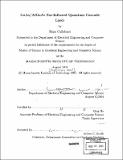| dc.contributor.advisor | Qing Hu. | en_US |
| dc.contributor.author | Callebaut, Hans, 1975- | en_US |
| dc.contributor.other | Massachusetts Institute of Technology. Dept. of Electrical Engineering and Computer Science. | en_US |
| dc.date.accessioned | 2009-01-30T16:55:14Z | |
| dc.date.available | 2009-01-30T16:55:14Z | |
| dc.date.copyright | 2001 | en_US |
| dc.date.issued | 2001 | en_US |
| dc.identifier.uri | http://hdl.handle.net/1721.1/44513 | |
| dc.description | Thesis (S.M.)--Massachusetts Institute of Technology, Dept. of Electrical Engineering and Computer Science, 2001. | en_US |
| dc.description | Includes bibliographical references (p. 123-127). | en_US |
| dc.description.abstract | In this thesis I investigated the feasibility of an optically pumped inter subband farinfrared (40-100[mu]m) laser, using GaAs/ AlxGal-xAs heterostructures. The proposed design aims to use LO-phonon-mediated depopulation of the lower THz laser level to aid the intersubband laser population inversion. Interband recombination occurs by means of stimulated emission, thus combining an interband (~1550 me V) and intersubband (~16-18 meV) laser. As the subband properties of both the valence band and the conduction band are important for this work, a numerical program code was developed for the valence band to supplement the available tools for the conduction band. The steady state rate equations for the proposed quantum well structure were solved self-consistently for several different carrier temperatures. The calculations indicate that a pump beam of moderate power (0.5-1 W) concentrated on a device of typical dimensions (104 cm2) can generate an intersuhb and gain of 20 cm-1 at 50 K for a THz emission linewidth of 2 meV. This gain level can suffice to obtain THz lasing action, provided that the cavity losses can be kept in check. The performance of the THz laser is predicted to be very dependent on electron temperature, mainly due to the opening of a parasitic LO-phonon channel between the THz laser levels. Interband lasing seems to be easier to obtain, as the calculated threshold pump intensity is lower than for the intersubband case. | en_US |
| dc.description.statementofresponsibility | by Hans Callebaut. | en_US |
| dc.format.extent | 127 p. | en_US |
| dc.language.iso | eng | en_US |
| dc.publisher | Massachusetts Institute of Technology | en_US |
| dc.rights | M.I.T. theses are protected by
copyright. They may be viewed from this source for any purpose, but
reproduction or distribution in any format is prohibited without written
permission. See provided URL for inquiries about permission. | en_US |
| dc.rights.uri | http://dspace.mit.edu/handle/1721.1/7582 | en_US |
| dc.subject | Electrical Engineering and Computer Science. | en_US |
| dc.title | GaAs/AlGaAs far-infrared quantum cascade laser | en_US |
| dc.type | Thesis | en_US |
| dc.description.degree | S.M. | en_US |
| dc.contributor.department | Massachusetts Institute of Technology. Department of Electrical Engineering and Computer Science | |
| dc.identifier.oclc | 50181368 | en_US |
